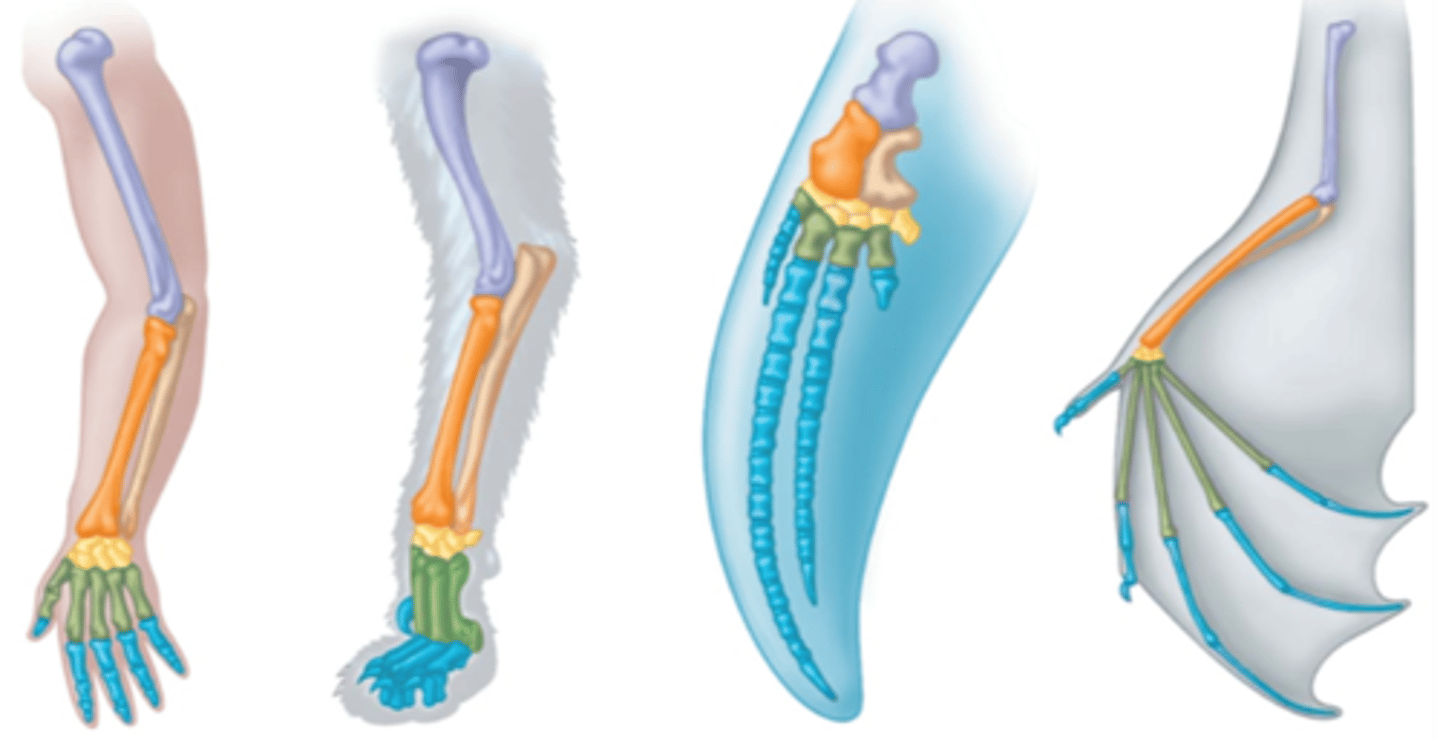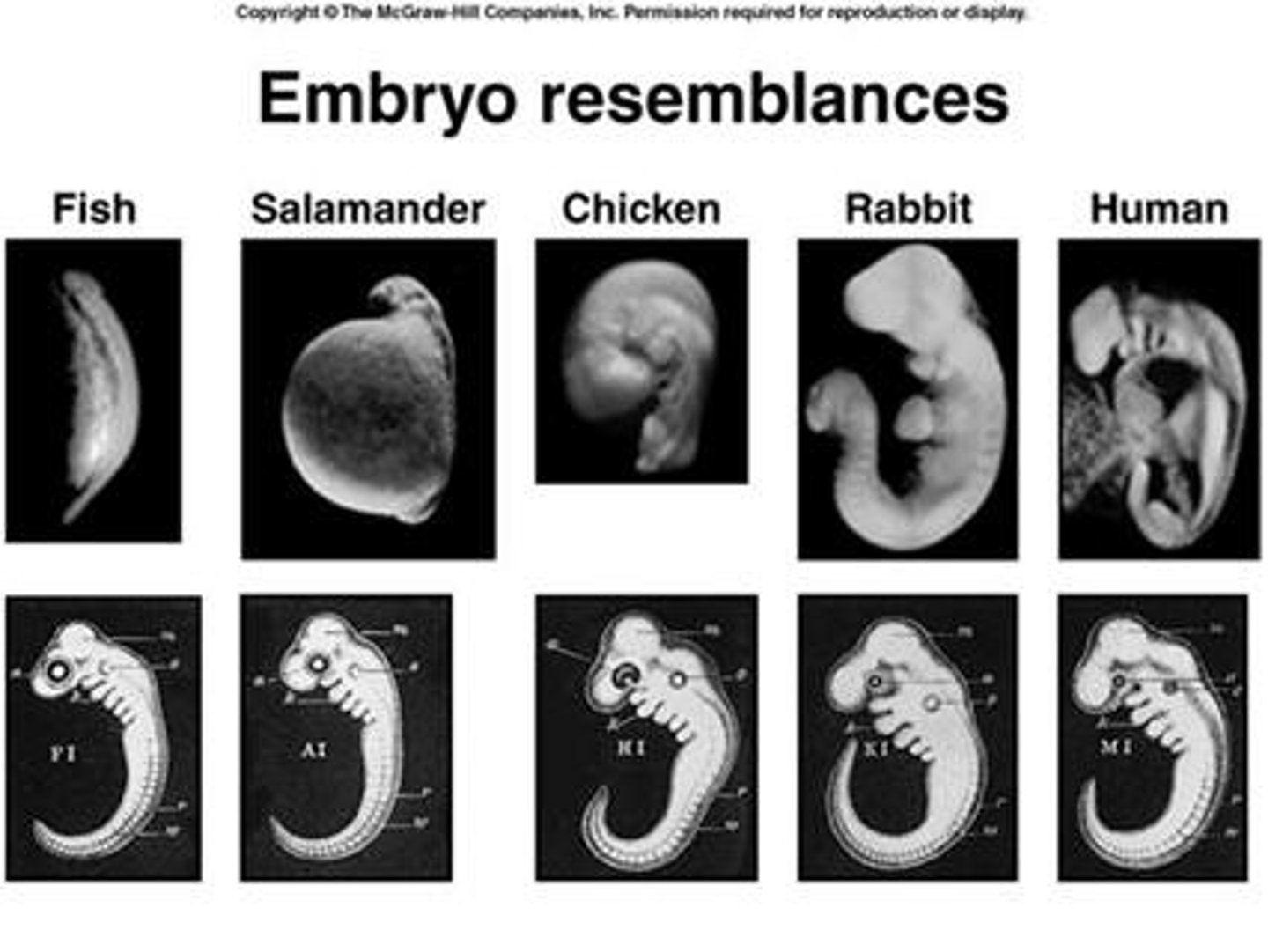Bio 101: Evolution
1/50
There's no tags or description
Looks like no tags are added yet.
Name | Mastery | Learn | Test | Matching | Spaced |
|---|
No study sessions yet.
51 Terms
Evolution:
Genetic change in a population or species over time.
What is the evolutionary unit?
Populations.
Gene pool:
All the alleles of a population.
Population:
All members of a species that live in a defined area.
What did Darwin observe to help create his theory of evolution and natural selection?
--The diversity of life
--Patterns of similarity
--Organisms suited to their environment
What is the evidence we have to support evolution?
The fossil records, Bio-geography, comparative anatomy, comparative embryology, and molecular biology.
How do the fossil records support evolution?
Transitional fossils show similarities in organisms new and old connecting them to the same ancestors.
How does bio-geography support evolution?
Bio-geography shows us the geographic distribution of species making it possible to relate species to a common ancestor based on location.
How does comparative anatomy support evolution?
--Biologists use vestigial structures to connect species to their ancestors.
--Finding species with similar anatomy helps connect them with each other.

Vestigial structure:
Remnants of features that served important functions to an organisms ancestors but have nearly disappeared due to evolutionary change when the organisms no longer requires that function for survival. (ex: whales have bones near the end of their body resembling those of a hip bone suggesting they originated from a four legged land animal.)
How does comparative embryology support evolution?
Similar embryo shapes suggest we all started off the same.

How does molecular biology support evolution?
Shows the similarity in DNA sequences between different species use to prove relations.
Natural selection:
Within a population some individuals may have variations that give them an advantage at survival, these will be the individuals with the best chance of survival and will likely pass these variations to their offspring and so on.
Micro-evolution:
--Evolution at its smallest scale.
--Changes in allele frequency in a population.
Macro-evolution
Changes going above the level of species.
Mechanisms of Micro-evolution:
Genetic drift, mutations, gene flow, natural selection.
Genetic drift:
Evolution of a population due to chance events. More effective on small populations.
Bottleneck effect:
Happens when genetic drift causes a big loss of genetic variation for small populations. Population bottlenecks occur when a population's size is reduced for at least one generation.
Mutations:
Permanent change in DNA, random events. ALL VARIATIONS COME FROM MUTATIONS.
Gene flow:
Genetic exchange with another population, may result in a gain or loss of alleles. reduces genetic differences between pop. (ex: red beetle moving into an area with blue beetles eventually they mate changing the alleles.)
Stabilizing selection:
Favors intermediate phenotypes, meaning selective pressure selects against two extremes of a trait creating phenotype that is shows stability of both phenotypes. (ex: tall plant affected by strong wind, small plant doesn't receive enough sunlight, pollinate together to created a medium plant that won't be effected by these factors.)
Disruptive selection:
Changes in population genetics that favors extreme values of a trait versus intermediate values. Variance of the value increases and population is separated into two distinct groups. (ex: same species of snail: some being dark shelled to hide in shady forest, some being light shelled to hide in well-lit bushy edges.)
Directional selection:
An extreme phenotype is favored over other phenotypes, causing the allele frequency to shift over time in the direction of that phenotype. (Same species of bird: some with short beaks, some with long beaks eventually all having long beaks to allow them more access to food)
Sexual dimorphism:
When differences in size, appearance, and behavior are shown between sexes. (ex: Male birds having red heads, females of same species have brown heads.)
Intra-sexual selection:
Individuals of same sex competing for mate. Usually seen in males. (ex: male lions fighting till death for love of lioness)
Mate choice:
Individuals of one sex being picky when selecting a mate. Usually seen in females.
Difference between natural selection and artificial selection?
Natural: Induced by natural causes
Artificial: Induced by humans
Allopatric speciation:
Formation of new species due to isolation.
Sympatric speciation:
Process through which new species evolve from a single ancestral species while inhabiting the same geographic region. (ex: two species forming from one species in same area.)
Species become more vulnerable to extinction when ________.
There is a lack of genetic variation.
The founder effect:
The loss of genetic variation that occurs when a new population is established by a very small number of individuals from a larger population.
What term did Darwin use to describe his broad theory of evolution?
"Decent with modification"
Darwinian fitness is measured by _____.
An organisms contribution to the gene pool of the next generation.
Branching evolution/ Adaptive radiation:
Biological diversity with the evolution of many different species from a common ancestor. (both are the same thing)
Evolutionary novelty:
Gradual refinement of existing structures for new functions.
Explosive evolution:
Occurs following the evolution of an important adaptation.
Animals are considered members of different species if they cannot_____.
Interbreed.
Prezygotic and Postzygotic isolation:
What keeps species in reproductive isolation with each other. (The reasons different species can't successfully reproduce.)
Prezygotic:
Defects in reproductive success between two species before fertilization. Hence PREzygotic.
Prezygotic sexual isolation mechanisms:
Mechanical isolation, temporal isolation, behavioral isolation, habitat isolation, gametic isolation.
Mechanical isolation:
Species unsuccessfully interbreeding due to incompatible sex organs.
Temporal isolation:
Species unsuccessfully interbreeding due to different breeding seasons.
Behavioral isolation:
Species unsuccessfully interbreeding due to difference in mating ritual.
Habitat isolation:
Species unsuccessfully interbreeding due to different preferences in living and mating habitat.
Gametic isolation:
Species unsuccessfully interbreeding due to incompatible sperm and egg restricting the zygote to form.
Postzygotic:
Defects in reproductive success between two species after successful fertilization. Hence POSTzygotic
Postzygotic sexual isolation mechanisms:
HYBRID INVIABILITY: Zygote either doesn't survive because parent chromosome are incompatible due to shape,size, or number or survives but doesn't live to reproduce.
HYBRID STERILITY: Hybrid adult unable to reproduce.
HYBRID BREAKDOWN: F2 generation is less viable than the F1 generation; meaning if hybrid survives to reproduce the offspring has even less of a chance at survival.
Homology (homologous structures):
Classification of similar anatomic structures. The homologous structures evolve from a recent common ancestor. Organisms with homologous structures are more closely related to each other on the tree of life than those with analogous structures.
Analogy (Analogous structures):
Does not indicate there is a recent common ancestor between two organisms. Even though the anatomical structures look similar and maybe even perform the same functions, they are actually a product of convergent evolution.
Convergent evolution:
Organisms with similar structures with similar functions due to natural selection and chance rather than ancestral relations. (convergent evolution results in analogous structures)
What is the likely cause of convergent evolution?
Organisms from different ancestors required a similar function for survival so they adapted in similar ways.